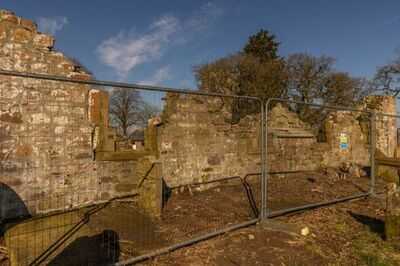
The Labour Government has been warned it could usher in a "tsunami" of church closures after slashing VAT relief for repairs on "the crown jewels" of UK heritage. Churches across Christian denominations contain the country's largest collection of art, sculpture and stained glass and make up around half of England's Grade-I listed buildings, but one in 20 could be forced to shut by the end of the decade. The National Churches Trust (NCT), an independent non-profit founded to support Anglican parishes, laid bare the crisis facing UK historic buildings during a conference in London this week.
An annual survey conducted by the charity showed that around 2,000 churches will definitely or probably close their doors by 2030, largely due to extortionate repair costs, totalling hundreds of thousands of pounds and shouldered almost entirely by dwindling congregations and poor communities. Spurred by growing secularism and ageing congregations, the crisis may have been a long time coming. However, some believe it has been exacerbated by Labour's decision to cut the budget of the Listed Places of Worship Scheme (LPOWS), which provides VAT relief for church repairs, by almost half as part of its attempt to claw back public funds.
In April, the Government introduced a cap of £25,000 in VAT relief per building, slashed the budget from £42 million to £23 million and refused to commit to extending it beyond March 2026.
The result is tantamount to imposing VAT on struggling parishes already mining church reserves and taking desperate fundraising measures to preserve some of the oldest buildings not just in the country but the whole of Europe, NCT chair Sir Phillip Rutnam told the Express.
"We asked a whole range of Government ministers to come to the conference," he added. "None of them did. It's really disappointing. We had everybody here apart from the Government - there just seems to be a total lack of interest there."
Alongside calling for greater certainty about the future of the LPOWS, Sir Phillip suggested a £50 million capital fund should be created to prevent church buildings from "crumbling on our watch", warning that "local people cannot shoulder the burden of spiralling repair and renovation costs any longer".
It is a problem evident across the country, including at St Grada and Holy Cross on the Lizard Peninsula in Cornwall, a Grade-I listed church with a 13th-century font and a 1522 brass memorial. The building's heritage has made it increasingly vulnerable to damage, however, often flooding during heavy periods of rain and with plants growing between the stones and gaps in the walls.
The extent of St Grada's repairs, including a hole in the roof caused by strong winds last winter, is estimated to total £450,000. The church has applied for a number of grants and launched fundraisers, including an annual sea shanty concert, but there is still a shortfall, widened by changes to the LPOWS.
"We have got to save the church," long-time supporter Wendy Elliott said. "It has stood here for hundreds and hundreds of years. It is not going to fall on our watch."
"Churches are the crown jewels of our heritage," historian Alice Loxton told the conference at the V&A on Tuesday. "Our museums have curated sets of objects, but that's often not the case with churches. These are incredibly old buildings, still in position and open to the public. You're following in the footsteps of visitors and worshippers of centuries past."
"Cultural vandalism is happening under our noses with the decay of parish churches," she added. "There's a tsunami coming if we do nothing about it. These buildings have persevered through war and bombing - are they going to be lost to the 21st century's bureaucracy, apathy and decline? Or will this be a galvanising turning point? The choice is ours to make."
Greg Pickup, CEO of the Churches Conservation Trust, an organisation that receives a small chunk of revenue from the Government each year to protect at-risk historic buildings, suggested that Labour's cost-cutting approach to the LPOWS could come back to bite them in the long run.
"We get funding from the Government to keep the buildings we look after alive and open because the state recognises that they have a role to play in doing so," he told the Express. "In cutting the LPOWS, which is a really lightweight, exemplary model of intervention, they're storing up a longer-term problem. The bills for repairing more severe issues in the future will come to us and eventually cost the state more."
"My personal sense is that there isn't a tidal wave, but more of a slow creep of closures coming," Mr Pickup added. "There's an ageing population, demographic change, secularisation and funding being cut. It'll be a death by a thousand cuts if we're not careful."
He also emphasised that the value of the UK's churches goes beyond their use in a religious capacity. "If nothing else, these buildings are treasure troves of our nation's heritage," said. "They are an unparalleled inheritance. If they were all combined in one place, they would equal or be better than pretty much any world heritage site you could name. But because they're so numerous and dispersed, we forget ourselves and take them for granted. And once you lose the church as a public building, it's gone for good."

Just over a fifth of UK churches are Grade-I listed or equivalent, while a third are Grade-II* listed and 40% are Grade-II listed. Despite this, many are in a poor or dangerous condition, with nearly four in 10 requiring urgent work on roofs, stonework and heating systems and a third admitting that their income doesn't cover running costs, leaving them reliant on reserves to stay afloat.
The rate of church closures in England has not yet reached the same pace as Scotland, where the national church is planning to close up to 40% of its buildings. But it is critical for the Government to recognise the preservation of these artefacts as "a shared heritage challenge", Sir Phillip said.
A tripartite capital fund could be devised between local communities, the Government and denominations including the Church of England and Catholic, Presbyterian and Methodist churches, it was suggested on Tuesday. The consensus was that none of the three parties could be expected to solely fund the historic buildings' preservation, but that the weight of responsibility currently rested disproportionately on the shoulders of retirees and volunteers, for whom it can be an acute source of stress.
"These are beautiful public assets with no permanent public support schemes," Dame Fiona Reynolds, former director-general of the National Trust, said. "There has been far too little money available [to look after them] in the last 50 years.
"People need beauty and spiritual succor, and churches can be extraordinary things. There are more food banks in churches than branches of McDonald's. But we need the support of a more helpful Government."
In an age of fragmented community and global instability, a hopeful vision for the future of UK churches might position them as dual spiritual and secular hubs, something that has already been widely realised but is endangered by the looming closures.
According to the NCT, 56% of UK churches are involved with food distribution such as foodbanks, with 37% offering it weekly, while 34% provide support for people struggling with anxiety, depression or isolation, and 49% host regular youth groups.
One of the conference's most touching moments was a panel discussion with Susie Mayhew, a former rough sleeper who struggled with addiction issues and was a victim of domestic abuse. Since being housed by the Hope to Action charity in Norwich, she has become an active member of a local church and credits it with helping to turn her life around.
"The community purpose churches serve is free, as far as the Government is concerned," Sir Phillip said. "Many people who come in are poor or struggling. It's a kind of social safety net."
In a similar vein to the three-pronged funding proposal, a nuanced approach should be taken to ensuring the future of UK churches, not just through securing financial support but recruiting new volunteers and publicising the church's value as a community space, attendees said.
"The main challenge is that people don't realise the situation and what they can do about it," Ian Morrison, director of policy and evidence at Historic England, suggested. "According to our polling, only one in 10 people know where the money to look after churches comes from, but 75% said it was important to them that churches remain open.
"This feeds into the idea that people will help if they know they're needed. We have to position churches as part of a shared national story. Communities have rallied to save pubs and village halls before. We've got no time to lose."
A Government spokesperson said: "Listed places of worship serve as vital community hubs for faith communities whilst providing valuable services to the wider public. Many are buildings of exceptional architectural and historical significance that form an integral part of our national heritage.
"The Listed Places of Worship Grant Scheme enables religious organisations to claim grants covering eligible VAT costs for essential repairs and renovations. This sits alongside substantial additional funding available through DCMS and our arm's length bodies, including £100 million from the National Lottery Heritage Fund allocated between 2023 and 2026, ensuring these treasured buildings can continue serving their communities for generations to come."
You may also like

Joao Fonseca makes emotional family statement as mum in tears after Swiss Indoors title

Chandrababu Naidu's governance has been vindictive towards farmers: Former Andhra minister Kakani Govardhan Reddy

'Truly creepy' Stephen King novel that inspired Welcome to Derry

NEP authorises states to bring out school textbooks: Kerala Education Minister

Nikhil Kumaraswamy hits back at DK Shivakumar, calls his remark on HD Kumaraswamy "a matter of concern"






